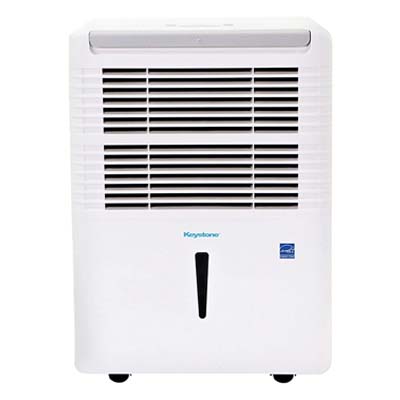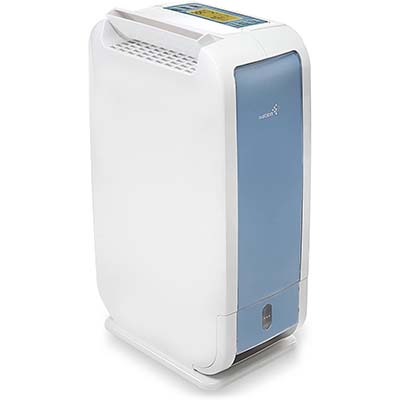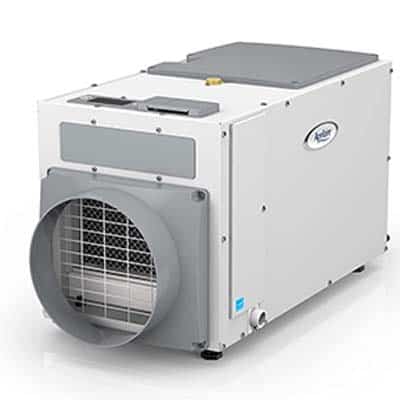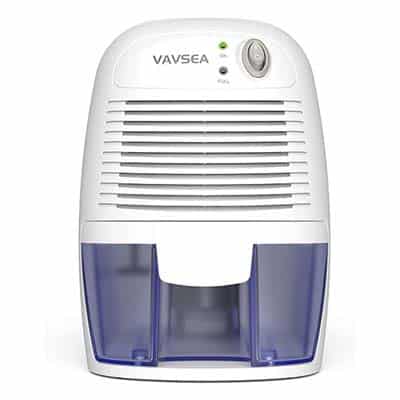So you’ve decided to purchase a dehumidifier to reduce the rising humidity levels in your home. Now, which unit should you choose to get the best results without any hassle?
In this article, we break down the different types of dehumidifiers so you can make an informed decision and find your perfect match. It’s time to kick humidity to the curb!
What is a Dehumidifier? A Brief Overview
A dehumidifier is an electrical appliance used to lower humidity levels in a damp area, such as a bedroom, basement, shop, or industrial area.
Keeping the humidity level between 30-50% during the summer and 30-40% during the winter is recommended.
If the humidity is much higher than this, it can lead to problems for home and health. People with allergies and asthma are especially at risk of developing more severe symptoms due to increased allergens such as dust mites, mildew, and mold.
Humidity can also cause corrosion, warp wooden structures, and attract pests.
A dehumidifier offers many benefits to prevent these issues by balancing the air in your home.
It works by removing the water vapor from the air, sucking in warm air, and separating the droplets using coolant-filled coils. The water is then stored in a tank while the dry air is pushed back out into the environment.
It seems simple enough, and we assure you that it’s a simple, reliable gadget to operate- but there are many dehumidifier types and sizes to choose from. That’s where things can get tricky.
The starting point is first to measure the area you want to dehumidify. Afterward, it’s important to understand the types of dehumidifiers for home use. There are even different types of industrial dehumidifiers.
We look at them all in the next section!
3 Main Kinds of Dehumidifiers
There are three main categories of dehumidifier systems. Each system is effective but may be better suited to a particular environment.
All dehumidifiers come with various features that consumers can choose from based on their personal needs.
The 3 main types are:
- Refrigerant (also called a compressor) dehumidifier
- Desiccant dehumidifier
- Whole-home dehumidifier
Let’s look at what they can do!
1. Refrigerant (Compressor) Dehumidifier
As the name suggests, this type of dehumidifier uses a similar process as your kitchen refrigerator to dry the surrounding air.
The refrigerant dehumidifier works by using a fan to suck in the warm air from a damp room. The air is cooled on a metal plate (coils), condensing the moisture from the air.
The condensed moisture drips into a tank, which will need to be dumped after some time, depending on how often you use the dehumidifier.
Some newer models have a self-draining system that nixes the inconvenience of having to dump the water tank.
This compressor-type dehumidifier will operate until the humidity is brought down to a sufficient level. Some units feature a Stand By mode that will automatically shut off once the desired humidity setting is reached.
BEST SUITED FOR:
A refrigerant dehumidifier is ideal for homes or rooms kept at a moderate, constant temperature. This technology is also the most popular and effective way to reduce humidity.
NOT SUITED FOR:
If you live in regions with lower temperatures, this type of setup is not meant to handle cold weather below 65°F/18°C. If ice forms on the coils, it can damage the machine, wasting money and leaving you without a dehumidifier.
Even if the machine is not damaged, it doesn’t perform at its best in a chilly environment. There are high-end refrigerant units with subzero settings, but they are generally more expensive.
2. Desiccant Type Dehumidifier
This type of dehumidifier utilizes a process that does not need to cool the air before removing the water vapor, like the compressor unit.
Instead, it uses an absorbent material called a desiccant to absorb moisture from the air.
Desiccant dehumidifiers work by slowly turning a wheel through humid air that is sucked in. The wheel is equipped with desiccant material, which draws out the moisture with each rotation.
The droplets are then disposed into a bucket, and the dry air is released back into the room.
Desiccant dehumidifiers tend to be quieter, lighter, and more compact than the refrigerant variety.
You also get the option of a drainage tube that automatically dumps the collected water into a sink or floor drain without any manual labor needed.
BEST SUITED FOR:
People who live in colder regions. Unlike the refrigerant unit, the desiccant system can handle subzero temperatures since it doesn’t utilize a cooling system. You can also get a mini dehumidifier for a bedroom, closet, or pantry since it’s light and quiet.
NOT SUITED FOR:
If you live in a warmer region, go for the refrigerant variety. Desiccants gobble up power (up to 600-800 watts per hour!), and the technology has been known to be more unreliable compared to refrigerants.
3. Whole House Dehumidifiers
Both refrigerant and desiccant humidifiers can be bought as portable units. This simply means that you can move them from area to area and plug them into an electrical power outlet for operation.
While this is beneficial for targeting specific areas, such as a bedroom or closet, some homes have a humidity problem that affects every room in the house.
Central air conditioning might make the air feel cooler, but HVAC systems do not reduce humidity.
In fact, by blasting your HVAC to improve the humidity, you risk overworking your system and racking up higher energy bills.
Instead, you may want to opt for a whole-house dehumidifier, which is built into your central HVAC system. It uses the refrigerant system to draw warm air into the coils, which cools and separates the water droplets.
BEST SUITED FOR:
Large residences, commercial properties, or industrial properties. Industrial dehumidifiers use a powerful refrigeration method to lower the dew point of incoming air.
NOT SUITED FOR:
People on a budget who want a quick, affordable fix for an apartment, garage, basement, or to preserve a special collection.
In-Home Dehumidifiers vs. Portable Dehumidifiers
A whole-house system is arguably the best type of dehumidifier because it is convenient and is powerful enough to keep an entire (residential, commercial, or industrial) building at a constant humidity level.
Portable dehumidifiers are indeed the most cost-effective solution that you can operate yourself without professional installation. Still, even if you dehumidify a room, humid air will always seep in under bedroom doors and windows from untreated areas.
As well, when the summer months hit, it can force your dehumidifier to overwork, increasing energy consumption and wearing out the system.
While an in-home dehumidifier is expensive, it will pay for itself in the long run since it can handle even the most unbearably humid days.
And, you won’t have to struggle with those messy water buckets. A drainage pipe carries the water to a drain immediately.
As mentioned, different types of portable dehumidifiers come with a drainage pipe instead of a bucket.
But one drawback is that you can only keep the dehumidifier positioned next to a drain or sink, limiting portability.
Types of Dehumidifiers Conclusion
There are many factors to consider when shopping for a dehumidifier since there are three main types of dehumidifiers to choose from, along with sizing and features. This includes the refrigerant, desiccant, and whole-house systems.
To conclude this article, all three types are highly effective at reducing humidity in the air.
For the best results, you must first measure the size of the area you want to dehumidify. Take into account the weather in your region, as one dehumidifier type may operate more effectively than another in a particular climate.
References & Resources:
- What Are the Differences Between Refrigerant and Dessicant Dehumidifiers?, Andrews Sykes.
- How Does a Dehumidifier Work, Essential Home and Garden.
- Types of Dehumidifiers: What is Right For You?, REVIEW THIS.
- Humidifier vs. Dehumidifier: What’s the Difference?, healthline.
- How to Install a Portable Dehumidifier the Right Way, CNET.




